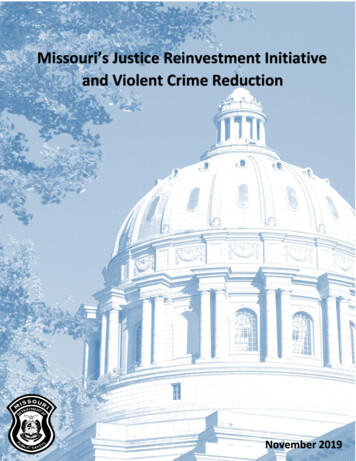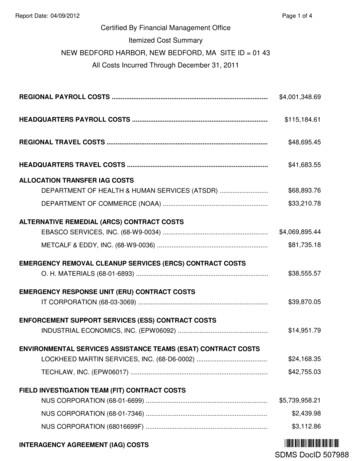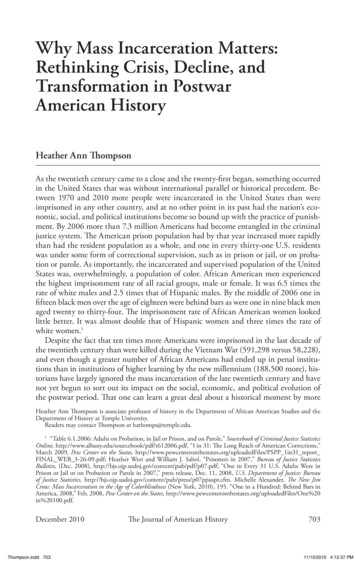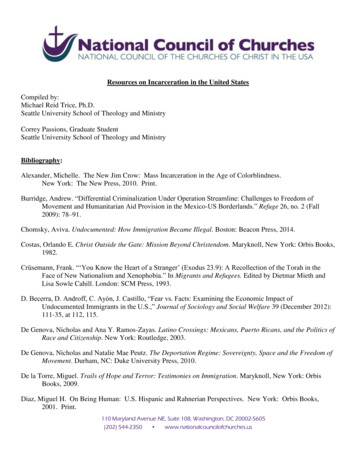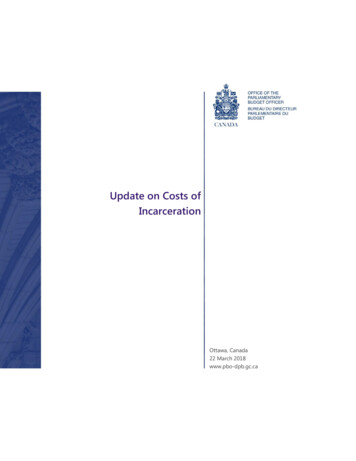
Transcription
Update on Costs ofIncarcerationOttawa, Canada22 March 2018www.pbo-dpb.gc.ca
The Parliamentary Budget Officer (PBO) supports Parliament by providinganalysis, including analysis of macro-economic and fiscal policy, for thepurposes of raising the quality of parliamentary debate and promotinggreater budget transparency and accountability.In June 2010, the PBO published a report assessing the financial cost of theTruth in Sentencing Act. In 2017, a member of the Senate requested that thePBO update certain details included in that report regarding the financialcosts of incarceration by gender and security level.This report was prepared by:Ben Segel-Brown, Research AssistantWith contributions to the analysis from:Mark Mahabir, General Counsel and Director of PolicyJason Jacques, Senior Director, Costing and Budgetary AnalysisNancy Beauchamp and Jocelyne Scrim assisted with the preparation of thereport for publication.Please contact pbo-dpb@parl.gc.ca for further information.Jean-Denis FréchetteParliamentary Budget Officer
Table of ContentsExecutive Summary11. Introduction31.1.Scope31.2.Security Classifications31.3.Segregation and other forms of isolation42. Overall Costs of Incarceration72.1.Breakdown of Operating Expenses72.2.Private Security Costs92.3.Inmate Transportation Costs3. Variation in Costs10113.1.Operating and Capital Costs113.2.Costs of Adding Capacity12Appendix A: Comparison to Provinces13Notes14
Update on Costs of IncarcerationExecutive SummaryThis report updates the Parliamentary Budget Officer’s estimates of thefinancial costs associated with offenders in federal custody. For this analysisthe costs associated with correctional interventions and internal services arenot included.In 2016-17, an average of 14,310 offenders were in federal custody. Theaverage institution-specific expenditure associated with each inmate were 114,587 /year or 314/day per offender and 96% of those cost areattributable to custody. The cost of incarceration varies substantiallydepending on the type of inmate, as outlined in the table below.Summary Table 1Estimated cost per offender, 2016-17Type of InmateMale MinimumAnnual 47,370Male Medium 75,077 206Female (all levels) 92,740 83,861 254Segregation (Incremental) 463,045 1,269Healing Lodge 122,796 336Youth 73,632 2021 139,128 381Male MaximumRegional Treatment CentreDaily 130 230Note:Only institution-specific costs are included. Female (all levels) includesminimum, medium and maximum and costs for for each type were notavailable.Source:Parliamentary Budget Officer. Model based on historical capacity and numberof inmates in segregation provided in CSC Response to PBO IR0305 andexpenditures from Public Accounts.When inmate population expand, correctional facilities must also beexpanded. The cost of expanding existing facilities also varied substantiallydepending on the type of inmate and is detailed in the table below.Summary Table 2Expansion Cost per Bed based on Security LevelSecurity LevelExpansion cost per bedMale Minimum 131,737Male Medium 100,236Male Maximum 175,759Women 259,894Women Structured Living Environment 533,7651
Update on Costs of IncarcerationSource:Correctional Service of Canada, Information Request IR0305.Large expansions of capacity would require constructing entirely newfacilities, which would entail higher costs.2
Update on Costs of Incarceration1. Introduction1.1. ScopeIn June 2010, the Parliamentary Budget Office (PBO) published a reportassessing the financial cost of the Truth in Sentencing Act, which limitedcredit for time served in pre-sentence custody. 2 The purpose of this report isto update estimates of the costs of incarceration used in that report.However, the estimated costs by security level set out in this report are notdirectly comparable because this report distinguishes costs associated withsegregation and excludes costs associated with correctional interventionsand internal services which were not institution specific. 3This update was undertaken at the request of a member of the Senate. In linewith that request, this report contains a particular focus on thedisaggregation of costs by security level, the costs of segregation, the costsof private security, and the cost of inmate transportation. There is extensiveexisting research regarding the cost savings associated with preventing crimeor allowing offenders to serve their sentences in the community. However,the focus of the request and this report is exclusively on the costs associatedwith offenders in federal custody.This report provides a starting point for understanding the financial cost ofproposals impacting levels of incarceration and segregation. The PBO’s focuson financial costs reflects PBO’s mandate and expertise and does not reflect ajudgement regarding the relative importance of financial cost considerationsin criminal justice policy-making.This report may be relevant to the review of issues relating to the humanrights of prisoners in the correctional system being undertaken by theStanding Senate Committee on Human Rights. 4 It may also be of relevanceto Parliament’s consideration of Bill C-56 An Act to amend the Correctionsand Conditional Release Act and the Abolition of Early Parole Act. 5 Federalcorrections are one of many interrelated components of public expendituresrelated to Criminal Justice in Canada, as outlined in the PBO’s 2013Expenditure Analysis of Criminal Justice in Canada. 61.2. Security ClassificationsThe Correctional Service of Canada (CSC) is responsible for inmates who havebeen convicted and sentenced to terms of more than two years. In 2016-17,an average of 14,310 offenders were in federal custody. CSC’s expenditures3
Update on Costs of Incarcerationassociated with custody centers in 2016-17 totaled 1.63 billion ( 114,587per inmate) of which 1.57 billion ( 109,971 per inmate or 96%) wasattributable to CSC custody program. 7The cost of incarcerating individuals varies substantially depending on thegender of the inmate and the security level to which they are assigned. Asexplained by the Correctional Service of Canada (CSC), there are threesecurity levels:In Maximum security the schedules that govern an inmate’s dayto-day routine are strict. The buildings are surrounded by a barbedwire fence and correctional officers are armed and posted instrategic locations.In Medium security the site is still fenced but the rules are lessrestrictive. Officers are not armed, although weapons are available –under lock and key – in specific locations.In Minimum security inmates live in living units (houses) in groupsof seven or eight. There is no barbed wired fence and there are noarmed officers. Inmates can organize their schedule according to theactivities they are required to participate in, and often areresponsible for their own meals. 8Men and women are housed in separate institutions, but a similarclassification applies to each. 9 Some institutions, particularly women’sinstitutions, hold inmates at multiple security levels. As of 31 March 2016,22% of federal inmates were in minimum security, 63% were in mediumsecurity, and 15% were in maximum security. 10Some offenders are supervised in the community at a much lower cost. In2016-17, an average of 8,572 offenders were supervised in the community atan average cost of 18,058/year. 111.3. Segregation and other forms of isolationThe Parliamentarian who requested this report inquired specifically about thecosts associated with segregation and other forms of isolation.Within each security level, an individual may be placed in administrative ordisciplinary segregation.Administrative segregation is intended to protect the safety and security ofthe individual and institution, or to facilitate an investigation. Administrativesegregation must be reviewed regularly, including daily visits by theinstitutional head and a registered health care professional. 12 As of 9 August2016, there were 360 inmates in administrative segregation, representing2.5% of the offender population. 134
Update on Costs of IncarcerationOf the offenders in administrative segregation, 205 offenders (57%) weresegregated based on safety and security, 142 (39%) were segregated basedon the inmate being in danger, and 13 (4%) were segregated to avoidinterference with an investigation. 14Most offenders in administrative segregation are in maximum or mediumsecurity. 15 Demographically, 98% of administratively segregated offenderswere male and 38% were aboriginal. 16 Table 1-1 summarizes the number ofindividuals in segregation as of 9 August 2016.Table 1-1Individuals in Segregation, tyMinimumSecurityUndetermined(ex. in intake)1701481230Notes:Figures as of August 9, 2016.Source:Correctional Service of Canada, Status Report on Administrative Segregation,2016In 2014-15, 1,574 out of 6,284 male inmates (25%) admitted to segregationwere placed there voluntarily, as were 19 out of 442 female inmates (4%)admitted to segregation. Voluntary administrative segregation occurs whenan inmate requests segregation and the institutional head believes onreasonable grounds that staying in general population would jeopardize theinmate’s own safety and there is no reasonable alternative. This distinction isno longer made and voluntary admissions may have been significantlyreduced by recent CSC policy changes. 17Disciplinary segregation occurs when an offender is found guilty of a seriousdisciplinary offence. 18 Disciplinary segregation may not exceed 30 days, or45 days when an inmate is ordered to serve a period of segregation whilehe/she is still serving a period of segregation for another serious offence. 19The average number of inmates in disciplinary segregation is not known.2011-12 data suggests that about 2.2% of admissions to segregation weredisciplinary which, given the legally limited duration of disciplinarysegregation, likely translates into an even smaller portion of the segregatedpopulation. 20 As a reference point for confirmation, 3% of admissions tosegregation in Ontario in 2016 were disciplinary. 21In addition to administrative and disciplinary segregation, inmates may beisolated from the general population to some extent in the Special HandlingUnit, a Regional Treatment Centre, or a Structured Living Environment.CSC has one Special Handling Unit, which is a facility that incarcerates “maleinmates who pose an ongoing danger to the public, staff and/or otherinmates, and who cannot be safely managed at any other maximum securityinstitution.” 225
Update on Costs of IncarcerationRegional Treatment Centres house inmates who are unable to function inparent institutions due to mental disorders, cognitive impairment, or physicaldisabilities associated with aging. They offer multiple levels of security andare provincially recognized hospitals or psychiatric hospitals. 23Structured Living Environments are a voluntary option available to minimumand medium security women with significant cognitive limitation and mentalhealth concerns. 246
Update on Costs of Incarceration2. Overall Costs of Incarceration2.1. Breakdown of Operating ExpensesAggregated cost data shows that almost three quarters of operatingexpenses associated with keeping federal inmates in custody are attributableto salaries and employee benefits. “Utilities, materials and supplies”,“Amortization of tangible capital assets” and “Professional and specialservices” also represent significant shares of total costs. 25 Table 2-1summarizes the expenses associated with custody for 2016-17.Table 2-1Operating Expenses Associated with Custody, 2016-17Total SpendingAverage cost per Inmate% of TotalSalaries and employee benefits1,102,774,00078,188.7470%Utilities, materials and supplies136,852,0009,703.069%Amortization of tangible capital assets127,889,0009,067.578%Professional and special services96,746,0006,859.476%Payment in lieu of taxes35,063,0002,486.032%Machinery and equipment28,779,0002,040.482%Repairs and maintenance27,693,0001,963.492%All other expenses17,891,0001,268.511%Total 1,573,687,000 109,971Notes:Correctional interventions and internal services are not included. Cost perinmate based on total spending divided by average custodial population(14,310).Source:Correctional Service of Canada, 2016-2017 Financial Statements, s 16.Most Correctional Service of Canada employees are involved in managinginmates in custody. The CSC has 0.72 Full-Time Equivalent Employees (FTEs)for each offender in custody (excluding correctional interventions andinternal services) or in other terms, an offender to staff ratio of 1.37:1.Community supervision is often delivered through contracts with communityorganizations, reducing CSC personnel requirements. Table 2-2 belowprovides the average number of offenders per FTE for various types ofactivities.7
Update on Costs of IncarcerationTable 2-2Average number of Full-time Equivalent Employees, 201617 Fiscal Correctional Interventions 264,05722,8825.64Community Supervision2268,57237.93Internal Services fendersper FTE1.37Notes:Offender per FTE based on personnel divided by applicable offenderpopulation.Source:FTEs from Correctional Service of Canada, 2016-17 Departmental ResultsReport.The major employee groups involved in custody at correctional institutionare identified below in Table 2-3.Table 2-3Correctional Institution Employees by Type, %,31 March 2016Correctional Officers57%Administration13%Health Care7%Program Staff6%295%Instructors/Supervisors3%Other (includes trades and food services)9%Parole Officers/Parole SupervisorsSource:Public Safety Canada, 2016 Corrections and Conditional Release StatisticalOverview at Figure B2.Federal Correctional Officers are unionized and paid between 55,970 and 74,985 per year excluding overtime. 30 The national average wage forcorrectional officers was 31.25/h, or 65,000 per year excluding overtime,with minimal variation in median wages across provinces. 318
Update on Costs of Incarceration2.2. Private Security CostsThe Parliamentarian who requested this report inquired specifically aboutprivate security costs.In the 2016-17 FY, the Correctional Service of Canada spent 12.8 million onprotective services; representing 0.8% of CSC’s budget, see Table 2-4.Table 2-4Protective Services Expenditures of Correctional Service ofCanada, various fiscal yearsSource:Fiscal YearExpenditures on Protective 003Receiver General for Canada, Public Accounts of Canada, Volume III, Section 3 –Professional and Special Services, various years.All payments over 100,000 for private security went to the Commissionaires,Public Works and Government Services Canada, or Canada Border ServicesAgency. While the Commissionaires do offer services related to the care,control and transfer of persons in custody they also provide a variety of otherprotection services, notably acting as security guards for federal governmentbuildings. 329
Update on Costs of Incarceration2.3. Inmate Transportation CostsThe Parliamentarian who requested this report inquired specifically abouttransportation costs. Public interest in inmate transfers was heightened bythe Office of the Correctional Investigator’s Investigation into the death ofAshley Smith, which highlighted that she was transferred 17 times in under ayear leading up to her death. Those transfers were primarily due toadministrative and capacity issues rather than any treatment plan. 33In the 2016-17 FY, the Correctional Service of Canada spent 4.9 million oninmate travel including associated salaries and overtime, representing 0.3%of CSC’s budget. Table 2-5 below details the components of travel costs.Table 2-5Transportation Cost Expenditures, 2012-13 to 2016-17fiscal yearsComponent of Transportation CostsDomestic TravelSource:Average % ofTransportation Costs52%International Travel2%Other Travel3%Total Operating Costs58%Salary15%Overtime27%Total Salary Costs42%Correctional Service of Canada, Information Request IR0305.There has been no clear trend in inmate transport costs over the last fivefiscal years, see Table 2-6.Table 2-6Expenditures on Inmate Transport, various fiscal yearsSource:Fiscal YearExpenditures on Inmate Transport2012-2013 3,512,4002013-2014 4,715,5892014-2015 4,330,4102015-2016 4,216,3632016-2017 4,873,505Correctional Service of Canada, Information Request IR0305.10
Update on Costs of Incarceration3. Variation in Costs3.1. Operating and Capital CostsThe PBO constructed a statistical model explaining 97% of variation infacility-specific expenditures across CSC facilities over the last five fiscal yearsusing inmate capacity by security level and segregated inmate populations. 34The results of the model are presented in Table 3-1.Table 3-1Estimated Cost per Offender by Security Level, 2016-17Type of InmateMale Minimum 47,370Daily 130Male Medium 75,077 206Male Maximum 92,740 254Female Multi 83,861 230Segregation (Incremental) 463,045 1,269Healing Lodge 122,796 336Youth 73,632 20235 139,128 381Regional Treatment CentreAnnualNote:Only institution-specific costs are included. Female Multi includes minimum,medium and maximum and costs for for each type were not available.Source:Parliamentary Budget Officer. Model based on historical capacity and numberof inmates in segregation provided in CSC Response to PBO IR0305 andexpenditures from Public Accounts.This statistical model suggests the inmates who are in or who cycle throughsegregation account for a disproportionate share of costs. Our modelsuggested an incremental daily cost for inmates in segregation ranging from 891 to 1,775. 36 CSC does not track resource requirements associated withinmates in segregation and was unable to provide a description of theresource requirements associated with segregation. Other stakeholders werealso unable to describe these resource requirements.11
Update on Costs of Incarceration3.2. Costs of Adding CapacityWhen inmate population expand, correctional facilities must also beexpanded. The costs of expanding existing facilities also varied substantiallydepending on the type of inmate. Table 3-2 presents the average costs perbed of expanding CSC custody centres based on projects completedbetween 2012-13 and 2016-17.Table 3-2Expansion Cost per Bed based on Security LevelSecurity LevelSource:Expansion cost per bedMale Minimum 131,737Male Medium 100,236Male Maximum 175,759Women 259,894Women Structured Living Environment 533,765Correctional Service of Canada, Information Request IR0305.The costs of constructing entirely new facilities is likely higher than the abovecosts of expanding facilities. In a 2009 Letter to the Standing Senate,Committee of Legal and Constitutional Affairs, the Commissioner of theCorrectional Service of Canada noted that prison construction costs dependon a variety of factors, but provided the following order-of-magnitudeestimates of capital costs which are provided in Table 3-3. 37Table 3-3Construction Cost of Correctional st per inmateMinimum 65 million250 260,000Medium 240 million400 400,000Maximum 240 million600 600,000Source:Parliamentary Budget Officer, The Funding Requirement and Impact of the“Truth in Sentencing Act” on the Correctional System in Canada, 22 June2010.12
Update on Costs of IncarcerationAppendix A:Comparison to ProvincesOnly one province, Ontario, has published figures regarding the number ofinmates who are in segregation. About 7% of inmates in Ontario are insegregation. 38The operational costs per inmate-year associated with incarceration varybetween provinces, with federal costs being higher than costs in mostprovinces, but lower than those in the territories, see Table A-1. 39Table A-1Average Costs per Inmate by Province, various fiscal yearsJurisdictionNewfoundland and 016 101,835 102,565 96,360 95,995 89,425Prince Edward Island 68,985 70,080 67,160 78,110 100,010Nova Scotia 61,685 75,920 74,095 69,715 93,075New Brunswick 62,415 66,430 66,795 75,555 71,175Quebec 71,175 68,255 67,890 73,365 78,110Ontario 67,160 67,160 72,270 79,570 78,475Manitoba 59,495 62,780 70,810 70,445 74,460Saskatchewan 54,750 53,290 58,035 60,590 60,590Alberta 43,800 44,895unkown 44,530 51,830British Columbia 64,605 65,335 72,635 77,745 73,730Yukon 89,790 97,820 129,940 137,970 115,705Northwest Territories 90,885 108,405 102,200 144,540 141,620Nunavut 153,665 162,790 206,590 218,270 203,670Federal jurisdiction 107,310 103,295 108,770 110,230 103,295Source:Statistics Canada, CANSIM table 251-0018 - Adult correctional services,operating expenditures for provincial, territorial and federal programs, annual.Federal and provincial inmate populations have different profiles and needswhich make comparisons difficult. Inmates in federal institutions have beenconvicted and sentenced to terms of more than two years. In contrast, mostinmates in provincial institutions (60%) are on remand, awaiting trial orsentencing, with the remainder (40%) sentenced to terms of less than twoyears. 40 Only 3.3% of sentences for men and 2.1% of sentences for womenare two years or longer, meaning federal institutions are only dealing withthe most serious offenders. 4113
Update on Costs of IncarcerationNotes1.Regional Treatment Centres house inmates who are unable to function inparent institutions due to mental disorders, cognitive impairment, or physicaldisabilities associated with aging.2.Parliamentary Budget Officer, The Funding Requirement and Impact of the“Truth in Sentencing Act” on the Correctional System in Canada, 22 June 2010.3.Correctional interventions provide assessment activities and programinterventions for federal offenders that are designed to assist theirrehabilitation and facilitate their successful reintegration into the community.Internal services are the ‘overhead’ functions which support the otherprograms or help meet corporate obligations, including oversight,communications, legal services, human resources management, financialmanagement, information management, information technologymanagement, real property services, material services, and acquisitionservice. See CSC, Departmental Results Report 2016-17.4.Details available via the Senate’s Website.5.Available via the Library of Parliament’s LEGISinfo service.6.Parliamentary Budget Office, Expenditure Analysis of Criminal Justice inCanada, 20 March 2013.7.Facility specific expenditures based on Public Accounts exclude expendituresassociated with national and regional headquarters and training colleges.Inmate number based on inmate numbers and custody expenditure reportedin the Correctional Service of Canada’s 2016-17 Departmental PerformanceReport. Custody expenditures based on segmented information inCorrectional Service of Canada’s 2016-17 Consolidated Financial Statements.8.Correctional Service Canada, Frequently Asked Questions, Updated 15August 2013.9.CSC Commissioners Directive 706: Classification of Institutions, 29 March2016 at Annex A: Definitions.10.Public Safety Canada, 2016 Corrections and Conditional Release StatisticalOverview at Figure C12.11. Correctional Service Canada, 2016-2017 Departmental Results Report at“Community Supervision.”12. Correctional Service Canada, Administrative Segregation, Updated 3 January2017.13. Correctional Service Canada, Status Report on Administrative Segregation, 8December 2016, at s 3.2.1.14
Update on Costs of Incarceration14. Correctional Service Canada, Status Report on Administrative Segregation, 8December 2016, at s 3.2.1.15. Correctional Service Canada, Status Report on Administrative Segregation, 8December 2016, at s 3.2.1.16. Correctional Service Canada, Status Report on Administrative Segregation, 8December 2016, at s 3.2.1.17. Public Safety Canada, 2015 Corrections and Conditional Release StatisticalOverview at C17. This distinction is no longer tracked.18. Correctional Service Canada, Status Report on Administrative Segregation, 8December 2016, at s 1.1.19. Correctional Service Canada, Status Report on Administrative Segregation, 8December 2016, at s 1.1.20. Office of the Correctional Investigator, Segregation in Canadian FederalCorrections: A Prison Ombudsman’s Perspective, 22-23 March 2013, under“Segregation Placements: Reasons”.21. Independent Review of Ontario Corrections, March 2017, at Figure 4.22. CSC Commissioners Directive 706: Classification of Institutions, 29 March2016 at Annex A: Definitions.23. CSC Commissioners Directive 706: Classification of Institutions, 29 March2016 at Annex A: Definitions.24. CSC Structured Living Environment Operational Plan at 1.2.25. Correctional Service of Canada, 2015-2016 Financial Statements, at s 17.26. Correctional interventions provide assessment activities and programinterventions for federal offenders that are designed to assist theirrehabilitation and facilitate their successful reintegration into the community.27. Internal services are the ‘overhead’ functions which support the otherprograms or help meet corporate obligations, including oversight,communications, legal services, human resources management, financialmanagement, information management, information technologymanagement, real property services, material services, and acquisitionservice. See CSC, Departmental Results Report 2016-17.28. The populations being served by the above programs overlap so this figureis not the sum of the populations served by each program. Rather it reflectsthe total persons being served by Correctional Service Canada programs.29. These parole officers are situated within institutions, with the responsibilityof preparing offenders for release.30. Agreement between the Treasury Board and Union of Canadian CorrectionalOfficers, 31 May 2014, at Annex A.31. Department of Employment and Social Development Canada, ExploreCareers – Job Market Report, under “Correctional Service Officers NOC 4422”under Wages tab and under Canada tab.32. Commissionaires, Security Solutions.15
Update on Costs of Incarceration33. Office of the Correctional Investigator, A Preventable Death, 20 June 2008 atpara 56.34. The figures for segregated inmates represent the incremental cost over andabove the cost associated with a regular inmate at their security level. Allother figures reflect the cost associated with capacity for one inmate at thespecified security level. Capacity is adjusted for historical changes in totalcapacity, but not for historical changes in the composition of capacity due todata limitations. Capacity was used rather than actual inmate counts becausecapacity could be disaggregated by security level. With occupancy at 98% ofcapacity across the five years of data available, capacity was a close proxy forinmates by security level. Certain facilities were excluded due to incompletedata (largely those which have closed or merged).35. Regional Treatment Centres house inmates who are unable to function inparent institutions due to mental disorders, cognitive impairment, or physicaldisabilities associated with aging.36. This is the 95% confidence range given by the PBO’s model.37. See Parliamentary Budget Officer, The Funding Requirement and Impact ofthe “Truth in Sentencing Act” on the Correctional System in Canada, 22 June2010, at 117.38. Independent Review of Ontario Corrections, March 2017, at III.39. Statistics Canada, Table 251-0018 -Adult correctional services, operatingexpenditures for provincial, territorial and federal programs, annual, CANSIM(database).40. Statistics Canada, Adult Correctional Statistics 2015-2016.41. Public Safety Canada, 2016 Corrections and Conditional Release StatisticalOverview at Table A6.16
2016, there were 360 inmates in administrative segregation, representing 2.5% of the offender population. 13. Update on Costs of Incarceration . 5. Of the offenders in administrative segregation, 205 offenders (57%) were segregated based on safety and security, 142 (39%) were segregated based
